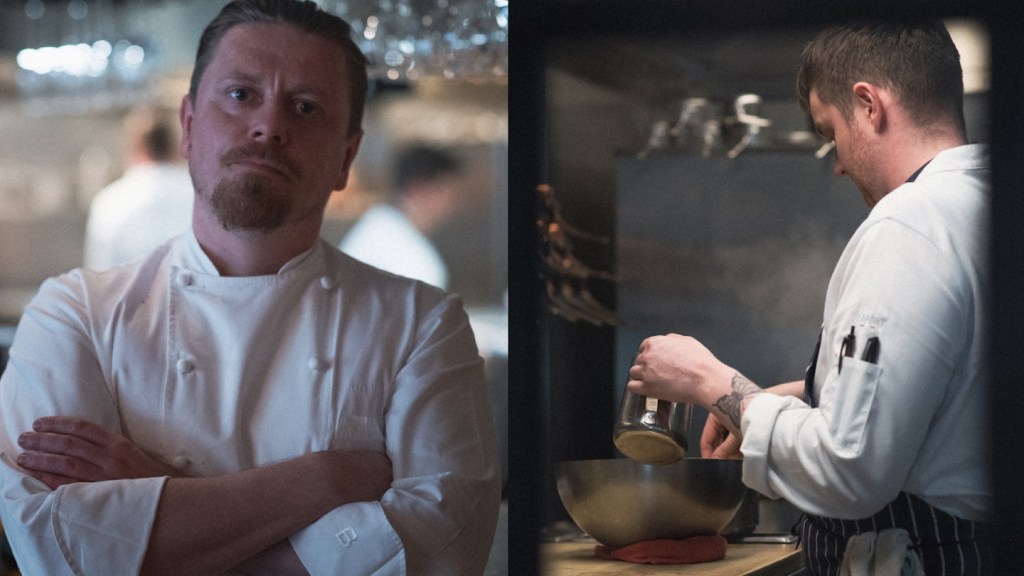Nick Chen-Yin is the owner and pitmaster of Smoke Signals Barbecue in Toronto. He agreed to let us in on some family secrets and convinced his grandmother to show us how to make a Hakka classic in her apartment.

Nick Chen-Yin. Photos Johnny CY Lam.
You could never serve this dish—at least this preparation—in a restaurant.
Videos by VICE
White people would just be like, “What the fuck? There’s a piece of bone and cartilage in here and why are the mustard green stalks so thick?!” They would be freaked out by it, I think.
Ham choy (pickled greens) and pork is a classic Hakka recipe that my grandmother made when I was growing up. Strictly speaking, Hakka is a dialect like Cantonese or Mandarin. The Hakka people aren’t limited to particular province in China; they’re spread across a more general region that spans a few provinces.
Most of the Hakka Chinese are very nomadic, so a lot of them had this diaspora from China during the Chinese War and a lot ended up in the Caribbean, Trinidad, Jamaica, even South Africa. So, if you meet a Chinese South African or Jamaican, there’s a 99 percent chance they’re Hakka.

This is a very poor dish; even some Cantonese Chinese—if they’re super poor or come from a peasant background—they would know about this dish. It just so happens that most Hakka Chinese are peasants, there are like literally no rich Hakka Chinese.
It’s totally the collard greens and barbecue pork shoulder of China. The pork cuts that you use are more generally considered like the “poor” cut like the rib or the shoulder, but it’s usually the belly, which you braise down with the pickled greens. You’re slowly rendering it down. You need the fat. You can’t use loin for this, it’s too lean.

RECIPE: Ham Choy and Pork
I’ve wondered if older versions of this would use smoked pork because they wouldn’t have access to fresh meat all the time, but there is very little history written about this dish. It just became a dish that you cooked. There wasn’t really any context—you just passed it down. Ham choy and pork belly is soul food. It’s Chinese soul food, it’s just straight-up home cooking.
Ham choy translates to “pickled greens” or “salted greens,” but it can be any green basically. Some use gai lan, bok choy, or yu choy, but my grandmother uses mustard greens that were pickled over a few days and then she mixes them with fermented black bean sauce and fresh pork.

My grandma—who’s in her 90s—is a boss in the kitchen. She just knows what the fuck she’s doing. I have huge respect for acclaimed chefs because of the creativity and skill that they bring to their dishes but at the end of the day, your fucking grandmother will be able to cook circles around any chef out there.
Getting the recipe for this was so fucking hard. I had to stop my grandmother at every step of the way to measure. I would ask her “How much soy sauce did you use for this?” and she would say, “I don’t know!” and I had to spoon out teaspoons to see how much she used. Which is kind of like at the restaurant, where I still have to weigh everything out to make sure the kitchen always gets it right.

There’s no measuring out soy sauce or water. She uses her senses to cook, looking at the pot, smelling it. She taught me to sharpen my senses and not rely on numbers and formulas. It’s like a spiritual influence.
At my restaurant we serve American barbecue, so my grandmother’s influence isn’t really in the type of food that I’m cooking but the technique—how she cooks. I also cook very much by sense and not by measure, which is really inherent in barbecue. You can measure the internal temperature of a brisket, but it’s just a guideline, it’s not a rule. There is a lot of using your sense of smell, touch, and sight.

I was watching how my grandmother butchers the meat, and it’s such a grandma way of doing it. It’s not proper butchery. She throws the rib bones in there and the riblets. She leaves these super thick layers of belly fat on there. Even how she chops the hamchoy—it’s so coarsely chopped and she leaves the stalks on.
But that’s what makes it home cooking. If you julienned the mustard greens and minced the pork, it just wouldn’t be the same.

Instead of browning the meat and then deglazing it with water and black bean sauce, she boils the water first and then puts the pork in there with black bean sauce. She thinks it’s too oily if you brown the meat. I thought it was unconventional, but I went along with it and it was exactly how I remembered the dish.
Grandmas have been doing it three times a day for 60 years, like Eddie Huang says. You cannot out-cook a grandmother. There is so much that we can learn from older generations. If you don’t, that tradition ends. If I’m not around, she’ll have no one to pass it on to and the recipe will die with her. If I don’t do this, ham choy and pork ceases to exist at a certain generation. To me, it’s really important to retain that. It’s part of your identity and your identity—it’s who you are.

You learn all these different family recipes and you’d be kind of a fool to not retain that knowledge. It’s a responsibility, but it’s one that I really embrace.

It’s cooking for your community. This is how poor Chinese cook for other poor Chinese and I think that’s very important. It’s very different from xiaolongbao or Peking duck, that’s not peasant food. I highly doubt any rich Chinese people eat this shit.
As told to Nick Rose.



